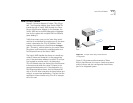
Virtual LANs (VLANS) 2-7
Virtual LANs (VLANS)
What is a VLAN
A VLAN is defined as a group of location- and topol-
ogy- independent devices that communicate as
though they were on the same physical LAN. This
means that they are not restricted by the hardware
that physically connects them, and segments are
defined by flexible user groups created by the user.
For example, with VLANS, the user can define a net-
work according to:
Department Groups—A VLAN could be created for
the Marketing Department, another VLAN for the
Finance Department, and still another for the Devel-
opment Department.
Hierarchical Groups—A VLAN could be created for
directors, another for managers, and still another for
general staff.
Usage Groups—A VLAN could be created for Email
users, another for multimedia users, and so on.
Advantages of VLAN
All 802 media and shared media support VLANs. In
addition, implementing VLANs:
■ Eases the change of devices
■ Helps control broadcast traffic
■ Provides extra security
VLANs facilitate the administration of logical groups
of stations that can communicate as though they
were on the same LAN. VLANs also facilitate moves,
adds, and changes of members of logical groups.
Traffic between VLANs is firewalled. This limits the
propagation of multicast and broadcast traffic
between VLANs.
Each distinct VLAN is uniquely identified throughout
the bridged LAN. A consistent representation of a
VLAN exists across a VLAN fabric (including FE and
ATM). This means that the shared VLAN knowledge
of a particular packet remains the same as the packet
travels from one point to another.
Port-Based Distribution
The switch uses a port-based approach to VLAN
functionality. This approach allows bridges to classify
all received tagged and untagged frames as belong-
ing to a particular VLAN.
NOTE: In port-based VLAN operation, the VLAN clas-
sification of an untagged frame is implicitly deter-
mined and bases on the port of arrival of the frame.
This facility requires association of a VLAN ID with
each of the bridge’s ports. Only received frames lack-
ing an explicit VLAN ID are subject to this impilcit clas-
sification.
Using the port-based approach, a specific VLAN ID is
associated with each bridge port. This VLAN ID,
known as a Port VLAN Idendtifier (PVID), provides the
VLAN classification for frames received through that
port. This value may be manager configured.


















